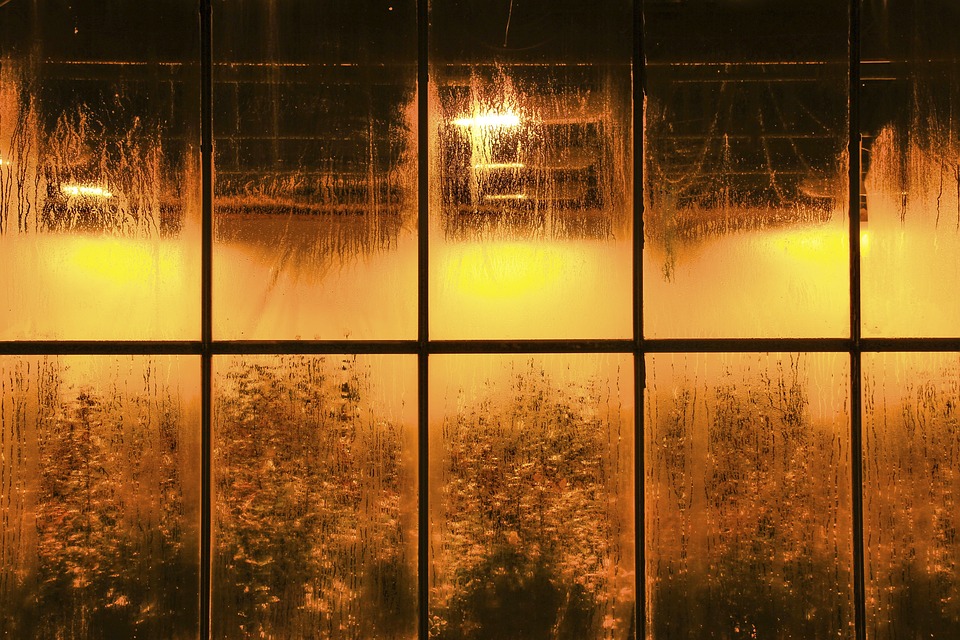Just the other day, an unusual cold front blew in, so we turned our heater on the night before in preparation. The next morning, the first thing my little boy did was run over to the window and start smacking his hands down in a small pool of water on the windowsill.
Now, at first glance, I was appalled because he had recently discovered how to create his own tiny puddles by spitting in the same spot over and over (#boymom). I went over to tell him to stop and start mopping up the mess when I noticed that it wasn’t spit at all (thank goodness!) but condensation that was streaming down the window. Condensation hadn’t happened to this extent before, and I was a little concerned as to why it started and what it might mean for my house in the future.
When warm air with tiny water particles hits something cold, it will form into water droplets—hence, condensation. We see this daily in the form of raindrops, a steamed up mirror after a hot shower, and, in my case, a river of condensation running down my windows.
Why now?
Since I don’t usually have a problem with condensation in my home, I took inventory of the changes within my household that might cause an increase in water particles in the air. The culprit: the humidifier in my kids’ room. Though the humidifier wasn’t even turned all the way up, the extra moisture in our house coupled with the cold front outside caused unusual condensation on the inside of our windows. Venting out the room better and turning down the humidifier helped us solve that problem, but if you regularly struggle with condensation within your home, you may need to take additional steps.
The reason you might have extra condensation is because you have excess moisture, insufficient ventilation, and a warmer interior temperature compared to the exterior temperature. It usually happens more often in the winter, but it can occur all year round in cool environments like the basement of your house.
Why is it a problem?
Though we normally see condensation on glass (mirrors, windows, etc.), it can also form on walls and furniture. This dampness can pose a significant problem if left unchecked. Mold can grow on the walls and ceiling, as well as on upholstery and clothing. If the paint on your walls is constantly wet, it may start to peel and develop dark black spots. Not only is the mold unsightly and can stain furniture, but it can also release spores into the air that can aggravate allergies and asthma.
What can I do about it?
Condensation does not discriminate: if the air is warm and humid, and there’s a cold surface somewhere to be found, the water droplets will gather. The best thing that you can do is prevent condensation to begin with. There are a few simple tricks to stop condensation before it even starts.
- Vent: Any place where there is a lot of moisture present, you need to use some kind of venting system. Turn on a heating unit in the bathroom before you even get into the shower to warm up the space and burn off some of the moisture. If you don’t have a heating unit in your bathroom, turn on your outside vent to move that moist air out of the bathroom. If you find yourself without a heating unit or outside vent, at least open up a window in your bathroom to help move some of the humid air outside. This will help prevent the humid shower air from condensing on your walls and mirror. The same goes for your kitchen. Crack a window and turn on a fan before you start cooking on the stove. That will help dissipate the moist air and help stop it from settling on your walls and windows.
- Cover and Close: If you are boiling water or heating a kettle on the stove, cover up the pot to keep steam from escaping unnecessarily. Additionally, try to keep the bathroom and kitchen doors closed when showering or cooking. This action, combined with proper ventilation, can get rid of condensation before it sneaks into the rest of your house.
- Monitor the Machines: I grew up in the Midwest where both the summers and winters were exceptionally humid. Because of that, we utilized a dehumidifier in our basement to keep condensation from forming on the walls. If you don’t have a dehumidifier and live in a humid place, consider investing in one. If, on the other hand, you live in a typically dry part of the country and you use a humidifier regularly, make sure to crack a window whenever you use it, and only use a setting appropriate for the space you are humidifying.
- Encourage Circulation: Mold can grow on clothing and other textiles if there isn’t enough circulation. To avoid this problem and encourage air circulation, position your furniture at least eight inches from the wall and don’t overfill your drawers and closets.
Condensation isn’t the end of the world, but it can be the precursor to worse problems and lead to damage that is costly to fix. Your best course of action is to take measures to prevent it in the first place.

